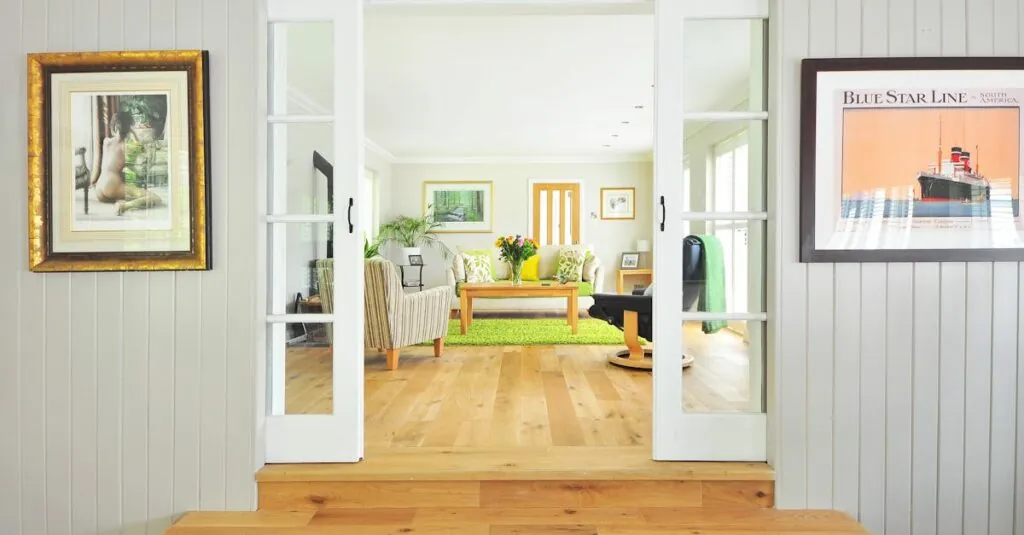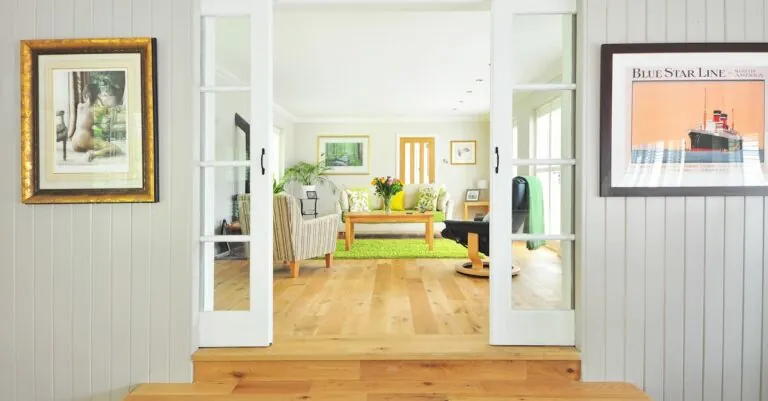Table of Contents
ToggleIn a world where clutter reigns supreme, living room minimalist interior design swoops in like a superhero with a cape made of sleek lines and neutral tones. Imagine a space where every item has a purpose and the only thing vying for attention is your favorite coffee table book—now that’s a vibe! Minimalism isn’t just about less stuff; it’s about creating a sanctuary that invites relaxation and sparks joy.
Understanding Living Room Minimalist Interior Design
Living room minimalist interior design emphasizes tranquility and purpose through stripped-down aesthetics. Its focus on simplicity contributes to creating serene spaces that enhance relaxation.
Key Principles of Minimalism
Less is more in minimalist design. Every piece in a living room serves a distinct purpose, eliminating unnecessary clutter. Clean lines and geometric shapes dominate furniture choices, promoting an open feel. Neutral tones, such as whites, greys, and beiges, create a cohesive palette, allowing natural light to flood the space. Functionality takes precedence over embellishment, providing comfort without overwhelming the senses.
Benefits of Minimalist Design in Living Rooms
Minimalist design offers various advantages in living environments. It fosters a calming atmosphere, reducing stress levels. A clutter-free space enhances focus, making it easier to unwind. Environmental impact decreases with fewer materials and less waste. Maintenance becomes simpler, as fewer items require cleaning and upkeep. Overall, minimalism cultivates a lifestyle centered on intentional living, where each element contributes to harmony.
Essential Elements of Minimalist Living Rooms
Minimalist living rooms embody simplicity and purpose. Each element plays a significant role in achieving tranquility and functionality.
Furniture Selection
Functional furniture serves as the cornerstone of minimalist design. Choose pieces with clean lines and a sleek profile to maintain an uncluttered space. Select multi-functional items like coffee tables with storage to maximize utility. Prioritize comfort along with simplicity, ensuring every piece invites relaxation. Limit the number of furniture items to maintain open space, promoting a feeling of airiness.
Color Palette
A cohesive color palette enhances the minimalist aesthetic. Neutral tones dominate, including whites, grays, and soft beiges, creating a soothing environment. Accent colors should be used sparingly to maintain visual clarity. Layering different shades within the same color family adds depth without overwhelming the senses. Consider using matte finishes for walls and furniture to minimize distractions, allowing natural light to flourish.
Lighting Considerations
Effective lighting brings warmth and ambiance to minimalist living rooms. Use a mix of natural light and artificial sources to create balance. Large windows allow daylight to fill the space, while carefully placed fixtures provide necessary illumination. Opt for pendant lights or floor lamps with simple designs that complement the overall decor. Incorporating dimmers on light switches promotes versatility, ensuring the atmosphere remains serene during varying times of day.
Creating a Cohesive Look
A cohesive look in minimalist interior design unifies elements in the living room, ensuring functionality and aesthetic appeal. Every piece should enhance the serene atmosphere of the space.
Accessories and Decor
Accessories play a pivotal role in achieving a minimalist feel. Select functional pieces like textured throws or thoughtfully chosen art that adhere to the color palette. Limit the number of decorative items to maintain openness. Use decor that complements the room, such as sculptural vases or anchored wall art. Prioritize quality over quantity, allowing each item to stand out without overwhelming the senses.
Layout and Space Management
Effective layout contributes significantly to a cohesive minimalist environment. Arrange furniture to promote flow and conversation while ensuring ease of movement. Create zones with strategic placement that encourages functionality. Open spaces foster relaxation, so choose multi-functional furniture like ottomans that serve as both seating and storage. Emphasize natural light by avoiding heavy drapes, opting instead for sheer fabrics that enhance visibility and warmth.
Incorporating Personal Touches
Minimalist interior design allows for the inclusion of personal touches that make a space truly unique. Individuality shines through thoughtful selections that enhance the overall aesthetic.
Art and Personal Items
Art pieces and personal items serve as focal points in a minimalist living room. Displaying a single large artwork instead of a gallery wall maintains clean lines and visual impact. Personal photographs, framed in simple, cohesive frames, can add warmth without cluttering the space. Choosing a few cherished items helps tell a story while keeping the environment serene. Balance is key; select pieces that resonate emotionally yet align with the room’s color palette.
Sustainable Practices in Minimalism
Sustainable practices elevate minimalist design by prioritizing eco-friendly choices. Opting for furniture made from reclaimed or sustainably sourced materials encourages responsible living. Using energy-efficient lighting contributes to both aesthetics and environmental care. Incorporating plants improves air quality while offering a touch of nature to the decor. Focusing on quality over quantity ensures longevity, reducing the need for frequent replacements and benefiting the planet.
Embracing minimalist interior design in the living room creates a tranquil oasis that fosters relaxation and intentional living. By prioritizing functional furniture and a cohesive color palette, individuals can craft spaces that not only look beautiful but also enhance daily life. The focus on quality over quantity ensures that each piece serves a purpose while contributing to a serene atmosphere.
Incorporating personal touches and sustainable practices further enriches the minimalist approach, allowing for individuality without compromising simplicity. Ultimately, a minimalist living room reflects a lifestyle that values clarity and peace, making it an ideal choice for those seeking balance in their homes.








